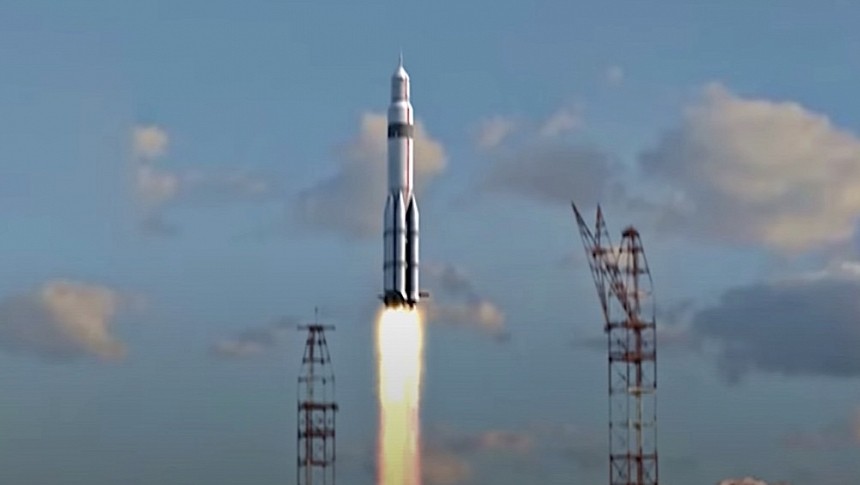The history of space exploration is filled with incredible achievements and undeniably memorable pieces of hardware. But for every success we've achieved in this field, there are many more failures and ideas that never came to pass. The Russian UR family of rockets is something that could have revolutionized space exploration, if only it had been made.
As it stands, our history recorded in the golden years of the space race the Saturn V as the most powerful rocket ever made. At 7.6 million pounds of thrust, it had no problem carrying to orbit 130 tons of cargo, and as much as 50 tons all the way to the Moon.
Closer to our time the Space Launch System (SLS) came along. This one generates 8.8 million pounds of thrust, and can haul beyond the reach of our planet's gravity, and even beyond that of the Moon, up to 27 tons of hardware.
And even more capable rockets, in the form of the SpaceX Starship, are on the way. But what if I told you our species could have reached these impressive figures a lot sooner in our history?
Back at the height of the space race, the Soviet Union was working on something called the Universal Rocket. UR for short, it should have comprised about five variants, starting with the ICBM-derived UR-100 and ending with the UR-900, the one meant to carry the Soviets all the way to Mars.
Somewhere close to the top was the UR-700, the Moon-bound hardware. If it had been made, the design would have shamed anything American, and one could say it would have eaten the Saturn Vs of its time for breakfast: over 150 tons of cargo to low-Earth orbit in standard configuration, and up to 250 tons when using a solid-core nuclear reactor.
This nuclear-powered rocket was called UR-700A. Just like the standard 700, it had a first stage powered by six boosters, a second stage that came with three engines, and topped that off with a third and fourth stage, both of them equipped with nuclear powerplants, and quite a lot of them – seven and three, respectively.
In essence, the UR-700A should have been capable of moving people to Mars orbit as well, not only the Moon. And if that had happened, the world we now live in would have been entirely different.
For reasons that are lost to time, this impressive space machine never came to be made. In fact, of all the UR rockets just three were actually flown, and none of them for the space missions they were intended for: the UR-100 remained an ICBM, and gave birth to the Strela and Rokot rockets, the UR-200 flew several times for testing but was eventually scrapped, and the UR-500 eventually became the Proton.
If you are a bit curious how the UR-700 Saturn killer would have looked like in flight, the animation video below, put together by Hazegrayart, shows just that: the take-off and flight of the technology, all the way to the Moon. Quite the sight!
Closer to our time the Space Launch System (SLS) came along. This one generates 8.8 million pounds of thrust, and can haul beyond the reach of our planet's gravity, and even beyond that of the Moon, up to 27 tons of hardware.
And even more capable rockets, in the form of the SpaceX Starship, are on the way. But what if I told you our species could have reached these impressive figures a lot sooner in our history?
Back at the height of the space race, the Soviet Union was working on something called the Universal Rocket. UR for short, it should have comprised about five variants, starting with the ICBM-derived UR-100 and ending with the UR-900, the one meant to carry the Soviets all the way to Mars.
Somewhere close to the top was the UR-700, the Moon-bound hardware. If it had been made, the design would have shamed anything American, and one could say it would have eaten the Saturn Vs of its time for breakfast: over 150 tons of cargo to low-Earth orbit in standard configuration, and up to 250 tons when using a solid-core nuclear reactor.
This nuclear-powered rocket was called UR-700A. Just like the standard 700, it had a first stage powered by six boosters, a second stage that came with three engines, and topped that off with a third and fourth stage, both of them equipped with nuclear powerplants, and quite a lot of them – seven and three, respectively.
In essence, the UR-700A should have been capable of moving people to Mars orbit as well, not only the Moon. And if that had happened, the world we now live in would have been entirely different.
For reasons that are lost to time, this impressive space machine never came to be made. In fact, of all the UR rockets just three were actually flown, and none of them for the space missions they were intended for: the UR-100 remained an ICBM, and gave birth to the Strela and Rokot rockets, the UR-200 flew several times for testing but was eventually scrapped, and the UR-500 eventually became the Proton.
If you are a bit curious how the UR-700 Saturn killer would have looked like in flight, the animation video below, put together by Hazegrayart, shows just that: the take-off and flight of the technology, all the way to the Moon. Quite the sight!








